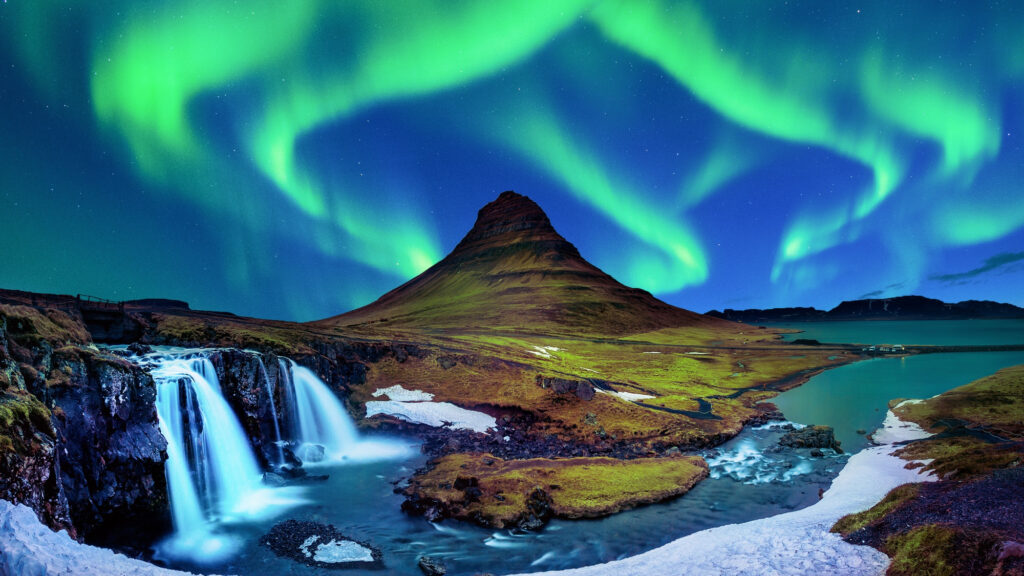The mesmerizing display of the Northern Lights, also known as the Aurora Borealis, is a celestial phenomenon that has captivated hearts and imaginations for centuries. As the night sky transforms into a canvas of vibrant colours, enthusiasts from around the world embark on journeys to witness this enchanting dance of light. In this comprehensive guide, we’ll explore the best places to see the Northern Lights, including Iceland, Sweden, Finland, Alaska, Norway, and Canada, and delve into the optimal times to experience this natural wonder.
Iceland
Iceland, a land of extremes, is renowned for its dynamic landscapes that seamlessly blend fire and ice. The juxtaposition of geysers, glaciers, and volcanic terrain creates a surreal backdrop for the Northern Lights. The best place to witness this cosmic spectacle in Iceland is away from city lights, and locations such as Thingvellir National Park or the remote Westfjords offer optimal viewing conditions.
Best Time to See Northern Lights in Iceland
The Northern Lights are visible in Iceland from late September to early April. The peak months are October to March when the nights are longest, providing ample darkness for the auroras to illuminate the sky.
Sweden
Sweden’s diverse landscapes, from vibrant cities to tranquil countryside, make it an ideal destination for Northern Lights enthusiasts. Abisko National Park, located in the Swedish Lapland, is renowned for its clear skies and minimal light pollution, offering an exceptional setting for witnessing the auroras.
Best Time to See Northern Lights in Sweden
The Northern Lights are visible in Sweden from September to March. The prime viewing months are during the winter, particularly from late November to early March, when the nights are longest.
Finland
Finland’s vast wilderness and pristine landscapes create a magical backdrop for Northern Lights enthusiasts. The northernmost region, Finnish Lapland, is a haven for aurora chasers. Remote locations such as Levi or Inari provide an immersive experience surrounded by nature.
Best Time to See Northern Lights in Finland
The Northern Lights are visible in Finland from late September to March. The peak months for aurora sightings are from October to February when the nights are darkest.
Alaska
Alaska, America’s last frontier, offers a unique blend of untamed wilderness and celestial wonders. The northern parts of the state, such as Fairbanks, provide an excellent vantage point for observing the Northern Lights against a backdrop of snow-covered landscapes.
Best Time to See Northern Lights in Alaska
Alaska’s Northern Lights season runs from late August to mid-April, with the peak months being from December to February when the nights are longest.
| ℹ️ Read More: | Where you can see Aurora Borealis in Alaska? |
Norway
Norway’s dramatic fjords and rich cultural heritage add a magical touch to the Northern Lights experience. Tromsø, situated in the Arctic Circle, is a popular destination for aurora enthusiasts. The combination of coastal beauty and clear skies enhances the chances of witnessing the celestial display.
| ℹ️ Read More: | Top 10 destinations to watch Northern Lights in Norway |
Best Time to See Northern Lights in Norway
The Northern Lights are visible in Norway from late September to early April. The peak months are from October to March when the nights are darkest.
Canada
Canada, with its vast expanse and diverse landscapes, offers multiple locations to experience the Northern Lights. Yellowknife in the Northwest Territories and Churchill in Manitoba are renowned for their aurora displays, providing a unique blend of northern lights and Canadian wilderness.
| ℹ️ Read More: | Where to see the Northern Lights in Canada |
Best Place to See Northern Lights in Canada
Yellowknife, in the Northwest Territories, is often regarded as one of the best places to see the Northern Lights in Canada. Its northern location and minimal light pollution make it a prime spot for aurora viewing.
ℹ️ View More
🏠 Best Places to Stay in Yellowknife
🗺️ Our Highly Recommended Tours in Yellowknife
ℹ️ Our Favourite Tours
Best Time to See Northern Lights in Canada
The Northern Lights are visible in Canada from late August to early April. The optimal months for aurora sightings are from September to April, with peak activity during the winter months.
Best Time to See Northern Lights: A Universal Guide
While the specific timing of the Northern Lights varies by location, there are some general guidelines that apply universally:
Winter Months
The Northern Lights are generally more visible during the winter months when nights are longest, providing extended periods of darkness for optimal viewing.
To maximize your chances of witnessing the Northern Lights, plan your trip during the optimal months, away from city lights, and embrace the magic of the night sky. As you embark on this celestial journey, the Northern Lights will undoubtedly leave an indelible mark on your heart and soul, creating memories that last a lifetime.
Geomagnetic Activity
Keep an eye on geomagnetic activity, measured by the Kp index. Higher Kp values, especially during solar storms, increase the likelihood of intense auroras.
Moon Phase
During the new moon phase, the night sky is at its darkest, enhancing the visibility of the Northern Lights. Planning your trip around this lunar phase can improve your chances of witnessing the auroras.
Conclusion: Embark on a Celestial Journey
The Northern Lights, a celestial ballet of light and colour, continue to inspire and awe those fortunate enough to witness this natural wonder. Whether you choose the Arctic landscapes of Iceland, the Scandinavian charm of Sweden and Finland, the wilderness of Alaska, the fjords of Norway, or the vastness of Canada, each destination offers a unique and unforgettable experience.
To maximize your chances of witnessing the Northern Lights, plan your trip during the optimal months, away from city lights, and embrace the magic of the night sky. As you embark on this celestial journey, the Northern Lights will undoubtedly leave an indelible mark on your heart and soul, creating memories that last a lifetime.







